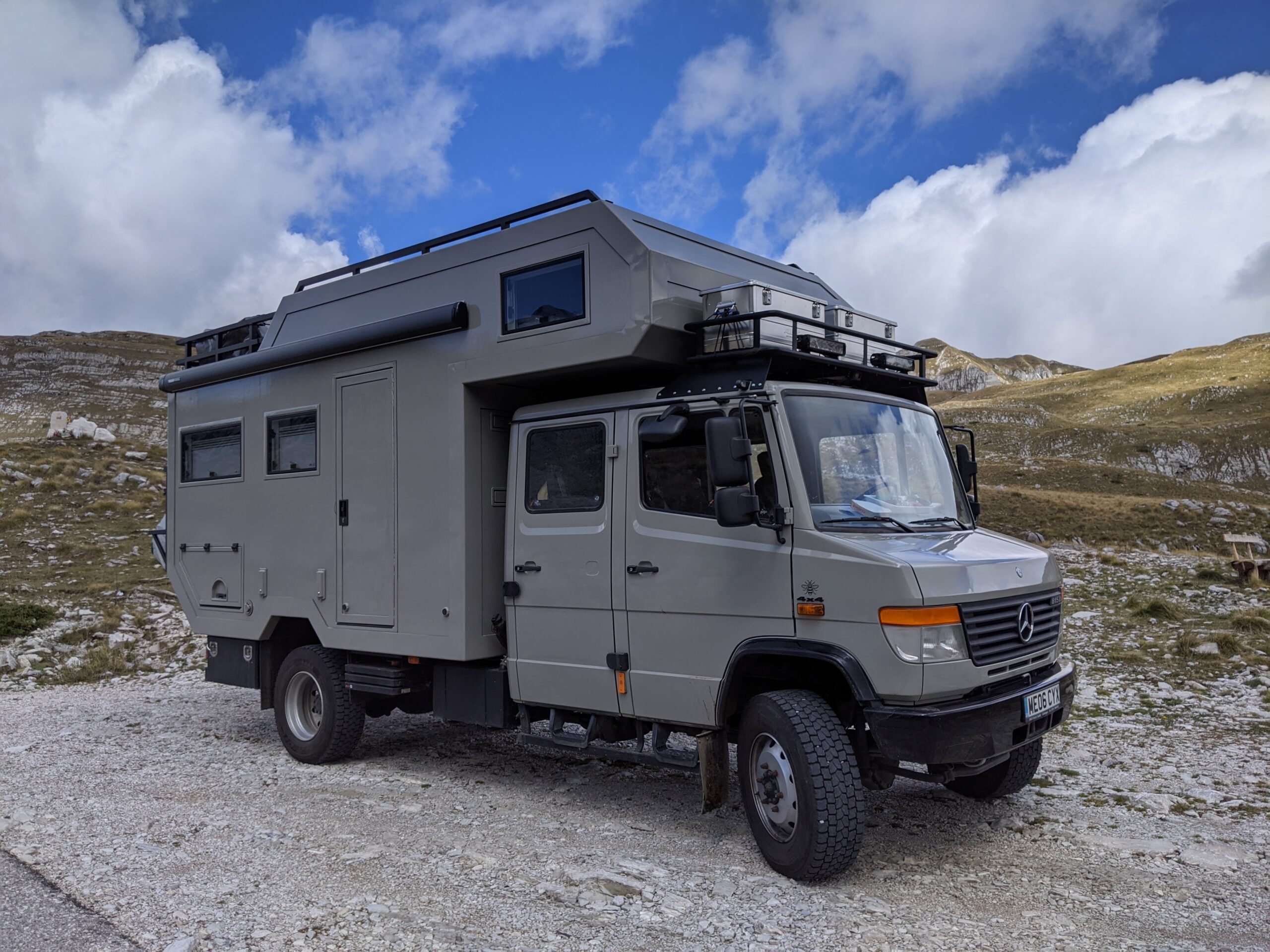There’s a big difference between a campervan and a motorhome; generally, the former is more compact and offers basic amenities, whilst the latter provides generous living accommodation and the comforts of home. I appreciate these are sweeping statements, and there are numerous exceptions to the rule, but broadly speaking, one remains a “van,” whilst the other is designed to be a mobile “home.” Le Truck World’s Vario 4×4 is nothing like a conventional motorhome, but it is truly a “rolling home,” one that is expertly engineered for comfortable long-term overland travel as a family. Interestingly, the Mercedes Vario 4×4 is one of the few vehicles that has tempted me away from my Volkswagen T3 Syncro. It perfectly bridges the gap between LWB van and 11-tonne-plus vehicles, whilst offering excellent all-terrain capabilities, a bombproof engine, dependable drivetrain, and, of course, benefits from Mercedes’ fabled accessibility of parts on every continent (owners have made it clear this isn’t always the case—check out my interview with Akela World for more on that).
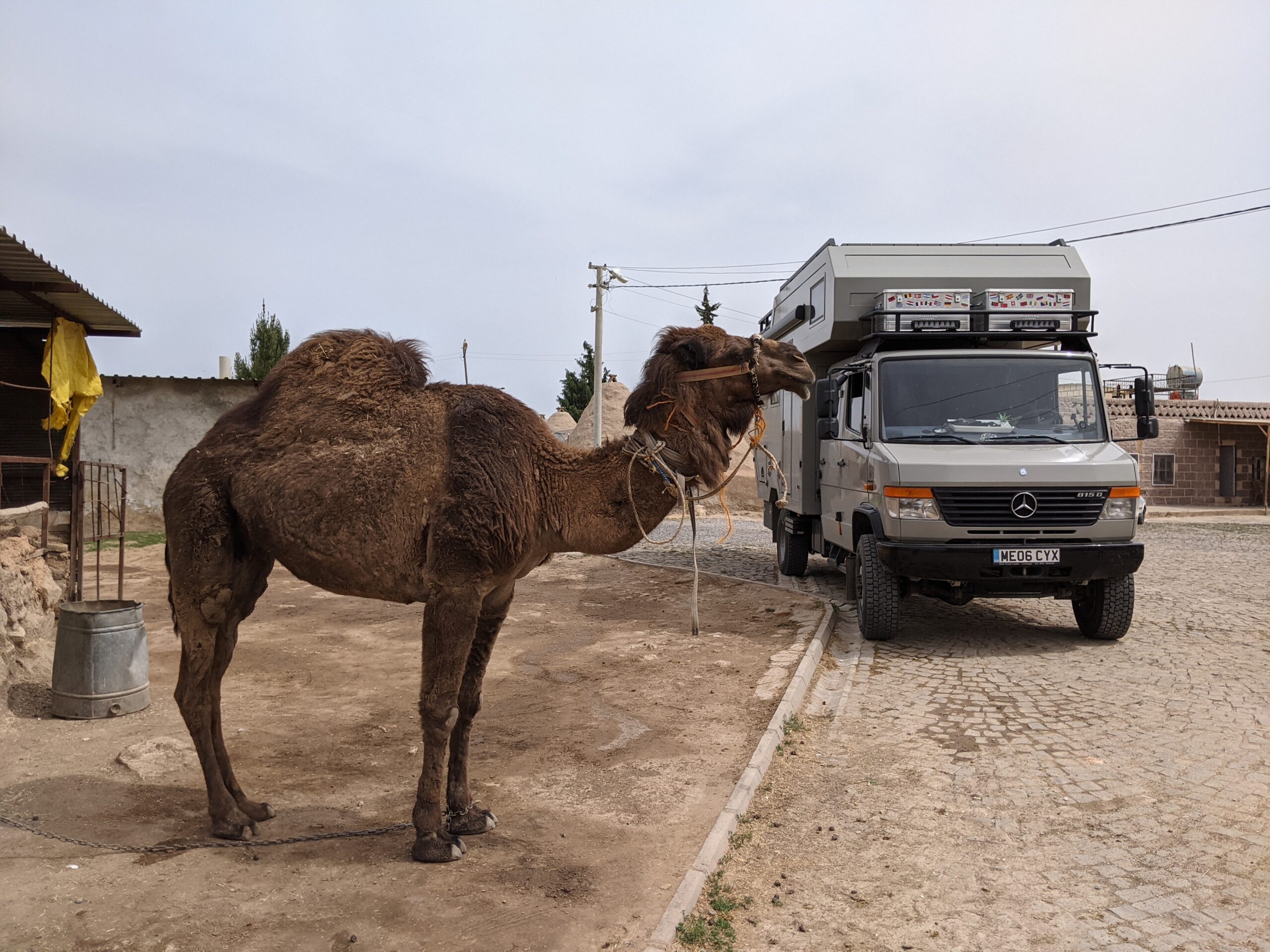
I’ve had the privilege to speak to a lot of overlanders, and I’d argue that for many, including myself, this life fell into place through a lot of trial and error. Nathan Day, the owner of today’s vehicle, provided an altogether more systematic transition to living on the road, making this case study all the more valuable to others considering the same lifestyle. I can share my story and recount the ups and downs, successes and failures, but this haphazard approach is not viable or particularly informative for many people considering long-term travel. I think what’s so impressive and inspiring about Nathan and his family’s journey is that it demonstrates a coordinated, almost textbook approach to transitioning from conventional static life to a more nomadic existence. Consequently, this interview provides a practical overview of working towards long-term adventure goals for families, couples, and individuals alike. Nathan was an absolute pleasure to interview: relaxed, cool, collected, and effortlessly funny. This is someone who’s not deterred by the scale of the challenge and instead is prepared to spend the time necessary and dig deep to achieve his goals whilst prioritising his family above all else. Le Truck World demonstrates that with careful long-term planning, commitment, passion, and an immovable vision, dreams really can come true. Thus, without further ado, let’s take a deep dive into Le Truck World’s mind-blowing build on one of my favourite base vehicles, the legendary Mercedes Vario 4×4.

Introduction
We’re a family of four: myself (Nathan); wife, Laura; two children, aged seven and nine, and we’ve been living on the road for approximately two years. We previously had a conventional motorhome, which the guys who built our current rig refer to as Tupperwares. My wife and I travelled a lot when we were younger, backpacking and that kind of thing. In terms of vehicle travel, my parents had a converted Bedford ambulance that we drove to Yugoslavia one summer, so I think that planted the seed. Five years ago, we decided to go away for six weeks during the kids’ summer break in our previous motorhome, largely staying at campsites, and we absolutely loved the freedom it granted. The following year we took our kids out of school a month earlier, which allowed us to travel for 10 weeks, but it still wasn’t enough. However, it showed us that we could live on the road without killing one another and that we worked well as a team. At the time, I was still working for a software business that I sold a few years ago, but after the trip, I decided to quit, and my wife similarly took a step back from her company. It was at this time that I discovered the world of overlanding and became completely hooked. Hence, before I knew it, I was on a plane to buy a Mercedes Vario 4×4.

The Build
I bought the Vario in February 2019, after deciding in January we wanted to transition to full-time life on the road. The Vario 4x4s are pretty rare, particularly as I was looking for a double-cab. But fortunately, within just a couple of weeks, I’d found one. It’s the 2006 edition, which is regarded as the perfect model in the Vario range, as it was the last engine before the new Euro emission regulations on diesels were introduced. All future models were modified to meet the new emission criteria, and this led to reliability issues. It was also the last engine to have the 5-speed box fitted, which was replaced by an in-house 6-speed transmission prone to failure. In other words, by 2006, the Vario had already been around for a long time, lots of research and development, which culminated with my 2006 model, considered the pinnacle in the range.
Why choose the Mercedes Vario 4×4 as an overlanding base vehicle?
I was initially looking at the Iveco Daily, but around the same time, I was made aware of the Vario. This coincided with a newfound interest in habitation pods, and the double-cab Vario seemed like the perfect base vehicle. People think the Vario is big, which it is in some respects, but compared to some overland vehicles, it’s not. In fact, it bridges the gap between a LWB van and the much larger MAN/DAF trucks. Living full-time [on the road], it’s nice to have the space for creature comforts: air conditioning, hot water, seating for four, bathroom, large fridge, etc., and it’s not so big that it prevents access to places (this happens rarely). Generally speaking, we can go anywhere with all the luxuries of home. This category of truck is limited. Sure, you could make the argument for the Iveco Daily or the Mitsubishi Fuso 4×4 when up-plated, but options are limited.
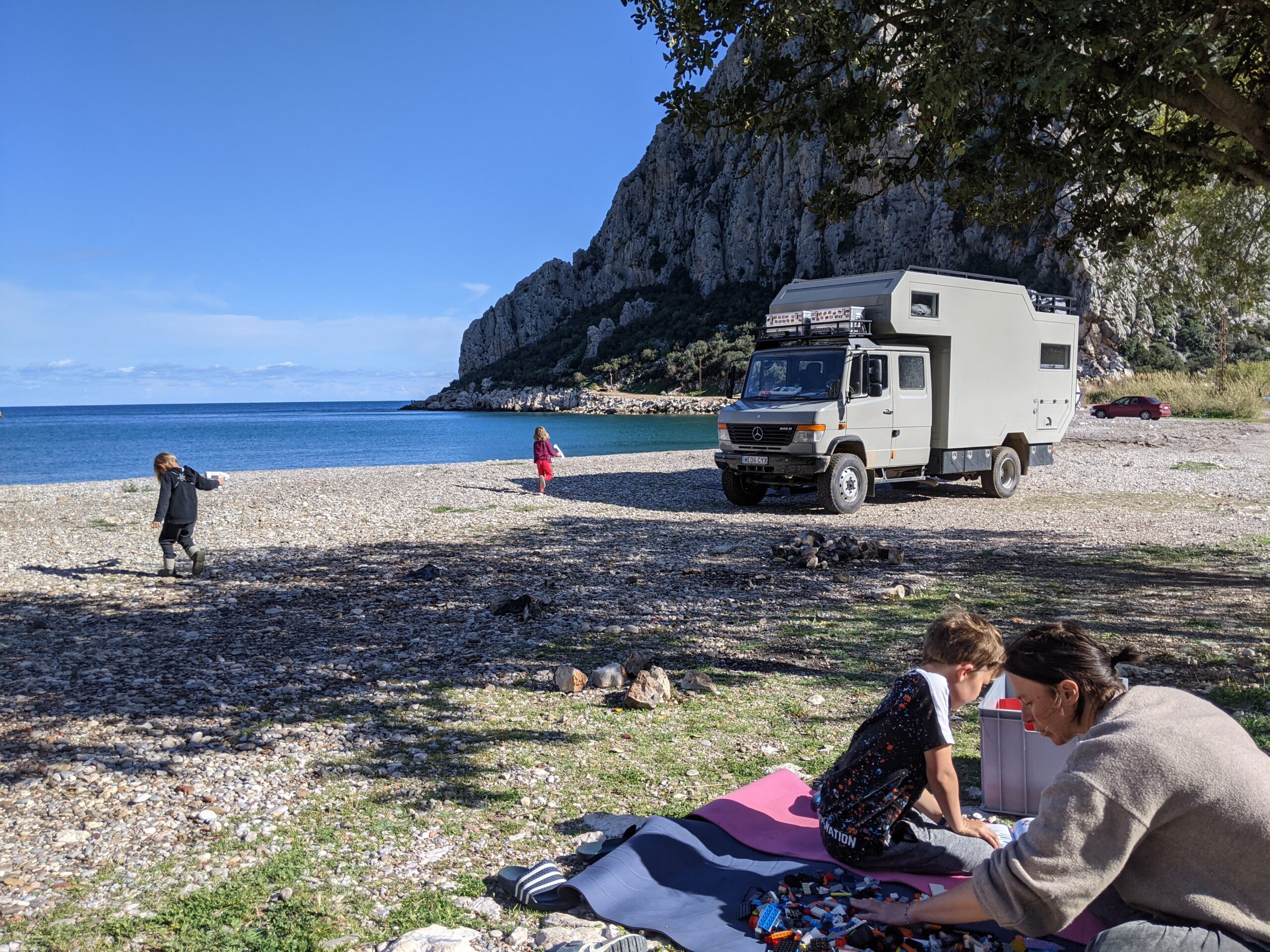
Engine and Drivetrain
It’s a 4.2-litre 4249 OM 904 LA diesel engine, originally the 815 (150 horsepower), but chipped to the 818 tune (181 horsepower), the most powerful variant in the range. The engine has been flawless, and any issues we’ve experienced have been self-inflicted. We converted the Vario to super single wheels, so the extra power has been useful and means we can cruise at a higher speed at relatively low revs. We also invested in stronger injector heads to cope with the additional pressure incurred by the remap.
The gearing has been kept stock (5-speed transmission with a low range box), and we can cruise at 100 kph (62 mph) on the highway in the green zone, around 2,000 RPM, which is very comfortable for the engine. In honesty, at 8 tonnes, that speed is plenty! The extra power means that even on steep ascents, whether that’s on- or off-road, with the low range engaged, it just powers them up fully laden.
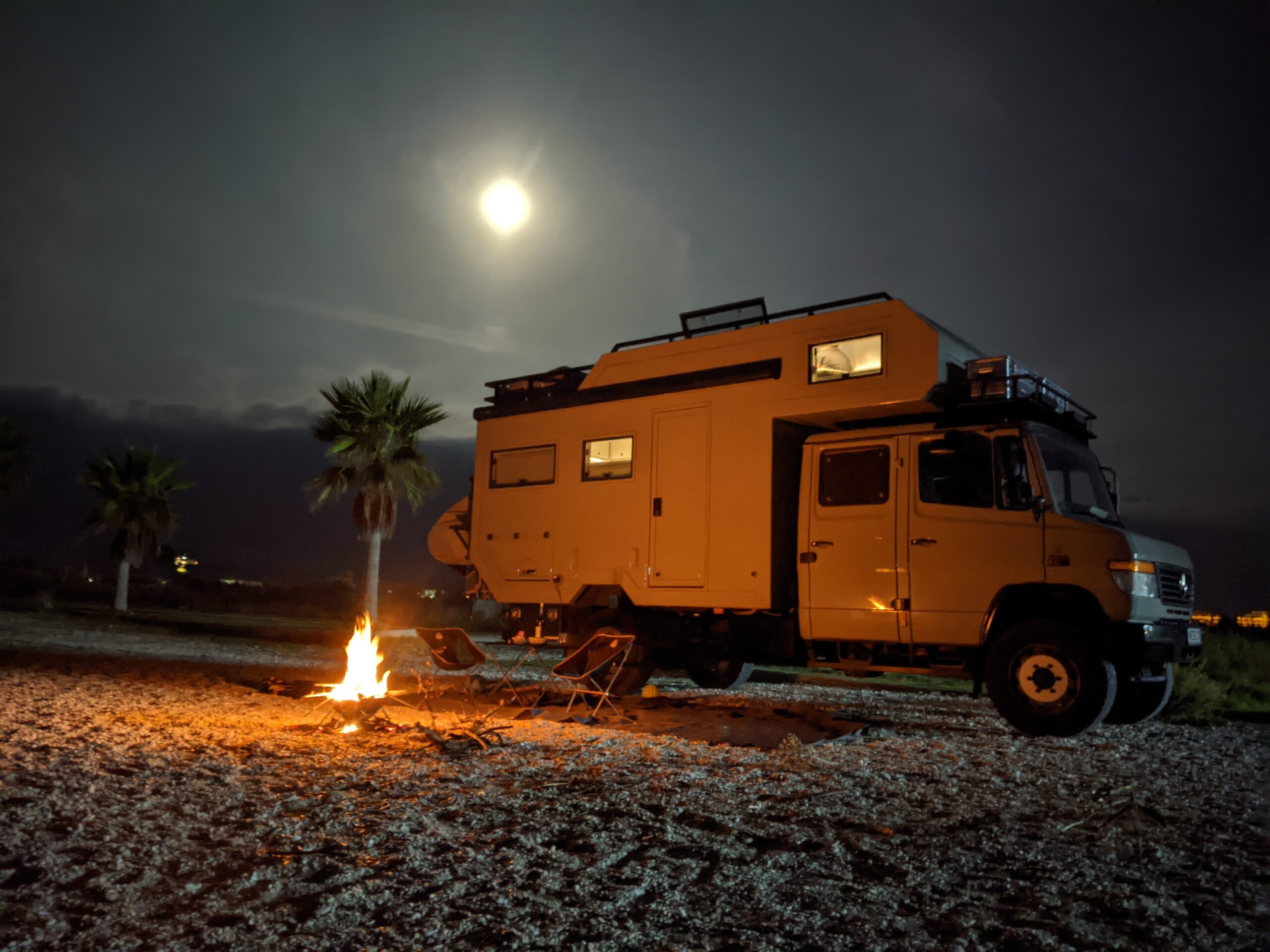
Suspension and Axles
We have rear and centre lockers; these came standard with the Vario. We’re running Marquart reinforced shocks/dampeners, but the suspension is largely stock. At the moment, we’re running a little heavy on the front axle due to the over cab/roof rack, and the super single conversion means the wheels are closer to the bodywork. Hence, other owners in a similar position have put a third leaf spring on the front to strengthen and raise it (approximately 3-4 centimetres), and we plan to do the same. I’ve dreamt about ripping out the stock and fitting full air suspension, but long-term travel has taught me to “keep it simple.” If you have a problem somewhere remote with limited resources, you need a setup that can be fixed with basic tools.

Wheels and Tires
We run “Super Single” GABO 19.5-inch steel rims (which are pretty much the biggest you can fit without making modifications—some people run 20-inch Unimog rims, but this requires work) on Pirelli TR:01 285/70R19.5 tires, and we chose not to opt for all-terrain tires for a couple of reasons. We spend most of our time on the road, and the AT tires are noisy and eat through fuel faster. In terms of the 19.5-tire category, there aren’t too many options, so we went for the Pirelli tire, which is made for mountain busses. Hence, some off-road capability, but mainly for climbing up and down the Italian alps (they’re also four-season and snow-rated). When we were skiing in Bulgaria this winter, it was just the snowploughs and the Vario that were getting to the top of the mountain, and that was without our snow socks (we use snow socks rather than chains due to the weight and size, but we’ve never needed them).

The Camper
The habitation pod was built by Twiga Travel Cars (twigatravelcars.nl) based in the Netherlands; it’s a small family outfit with around eight people working there. I did speak to some of the bigger German overland outfitters but didn’t get the same vibe. Twiga was really nice to work with, and after a lot of research, we got stuck in. We jointly worked on the layout based on our experiences of living on the road as a family in conjunction with their expertise in building overland vehicles.

The body is constructed using an aluminium frame, which is a fairly new approach for the larger habitation pods on bigger trucks, which traditionally use steel. The quality of the aluminium frame is unbelievable; you can’t even see the welds—it’s beautifully engineered and super strong. We’ve thrown this thing around for two years, and the joinery hasn’t shifted one millimetre. We have 60-millimetre fibreglass panels, glued to the inside of the frame to prevent any cold bridges in the build. Even without the air conditioning (Dometic Freshwell AC) or heater (Webasto Air Top 40 High Altitude diesel heater), it remains cool in the summer and warm in the winter. In freezing temperatures, we actually only have the heating on for 20 minutes to half an hour before it gets too hot. It was -15°C (5°F) when we were skiing, and most of the time, we kept the roof window open.
There’s a U-shaped seating area in the back, and the table drops to create a 1.5- by 2.2-metre bed whilst the kids sleep in the over-cab area. The over-cab is huge, probably big enough to sleep four people. This means the kids can go to bed, and we can continue our evening downstairs. We have a crawl-through to the cab, which is super useful, and the kids use that all the time. We have a compact kitchen area on the right, and a large Isotherm fridge/freezer as you enter. The truck is 24 volts, as is the majority of the habitation side, but we drop down to 12 volts for certain appliances.
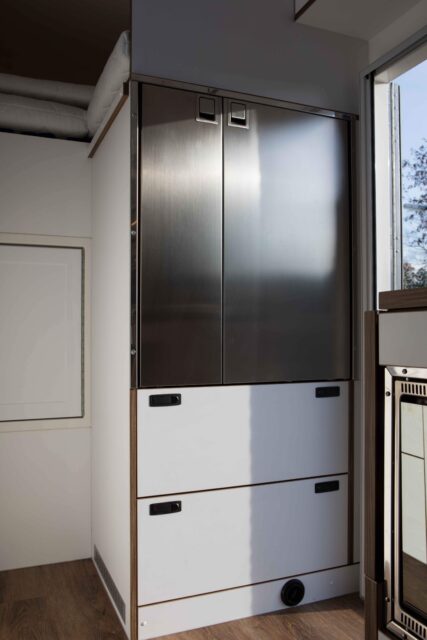
There’s a wet room, shower (we also have an outside shower), and a composting toilet. I have to say that the Separett composting toilet was one of the best decisions we made for the build. We originally had a chemical toilet, and every couple of days, it needed to be emptied, whilst the composting toilet can go for weeks. Water capacity is 265 litres (58 gallons) of cold and 24 litres (5.3 gallons) of hot, which I appreciate isn’t a huge amount compared to some larger rigs, but it lasts us around 10 days, and we find it easy to resupply at gas/service stations. We have two particulate filters, plus an ultraviolet light, and that means we can put pretty much anything in our tank and have safe drinkable water (the shower uses the same filtered water).
Power
It’s a full-Victron setup with 400aH of Victron 24v LiFePO4 batteries, which is enough for us. We don’t have an induction hob because we wanted the ability to utilise different fuel sources, and electrics can be temperamental. Thus, we opted for a Dometic OG 3000 oven and a Can 3-burner hob for our cooking needs. It’s also worth mentioning that we’ve met a lot of people running induction hobs, and they all mentioned how quickly this system burns through batteries. However, we do have a large, albeit super-efficient, Isotherm Cruise 200 Inox fridge-freezer which is awesome, and an Isotherm 600-watt 24-litre electric boiler. We have 600 watts of solar and a strong alternator with the Victron Buck-Boost relay, which kicks out 1,400 watts. Subsequently, on a sunny day, whilst driving, we can be charging at 2,000 watts or so. During the summertime, we never have to plug in, which is perfect for overlanding off-grid.
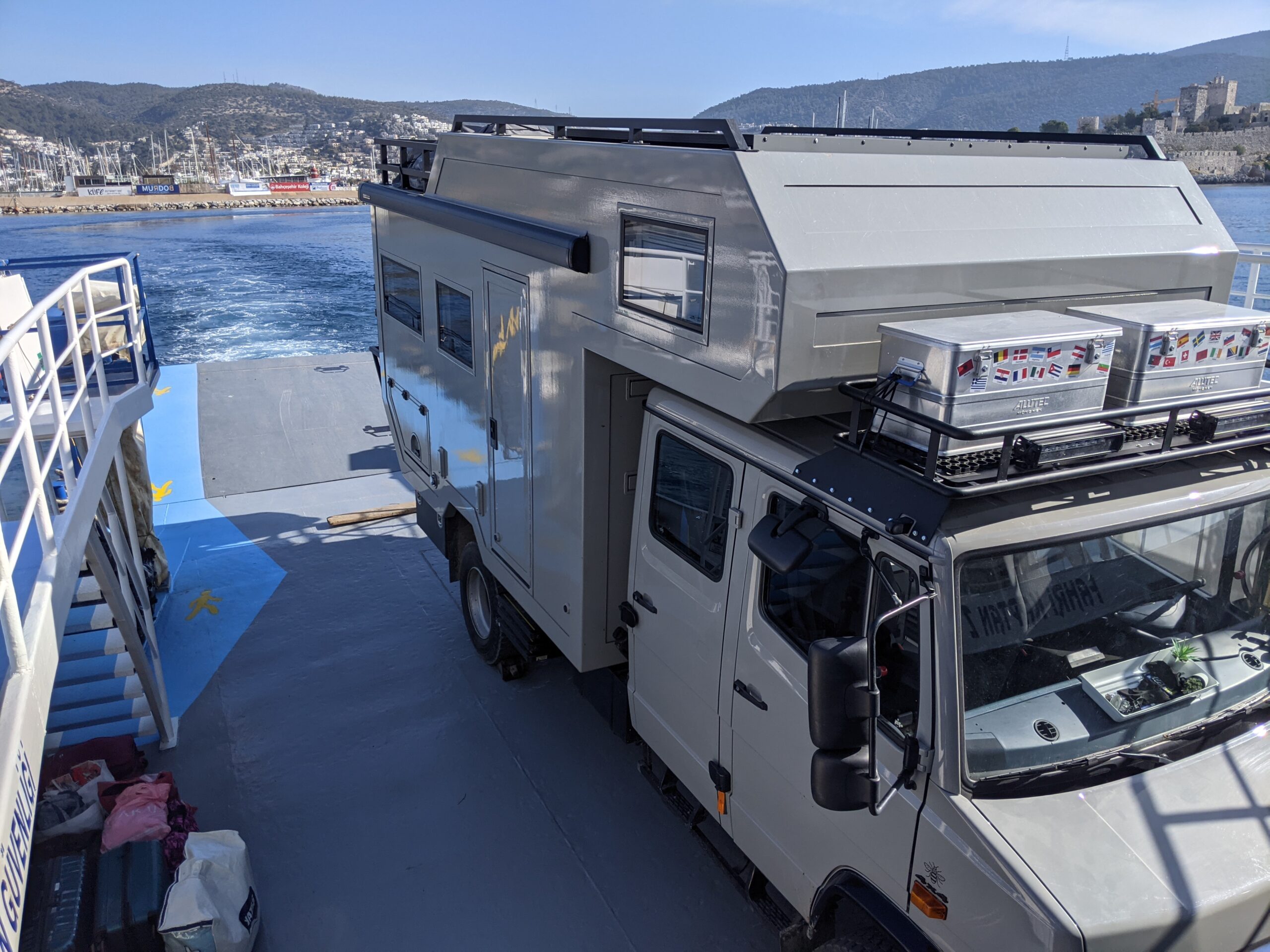
Recovery Gear
We have four sand ladders, which are kept on the rear of the Vario and have been used a few times on soft mud/sand. I’ll be fitting a winch the next time we stop travelling as I’ve only been stuck twice. On both occasions, it would’ve gotten me out of the situation without requiring the help of another vehicle. The Vario was fitted stock with a compressor, so we’ve tapped into the system and have connection points on either side of the vehicle. On the highway, we run about 7.5 bar on the front axle and 8 bar on the rear, and have been as low as 1.5-2 bar in places like Chile. We carry two spare tires; one is fitted to a rim, the other is not. We decided to go for solid steel wheels rather than split rims to keep things simple. Instead, if we get a puncture, we have a complete wheel to replace it. Then in the next town, we replace the knackered tire with our spare and simply order a new spare tire two weeks down the line, or wherever is convenient.

Build Conclusions
There’s nothing major that we’d change. We have an outside shower next to the entry door, which isn’t ideal as it creates a pool of water that we then walk through to get in. Therefore, we’d like to put an additional shower on the opposite side of the truck. I also wonder sometimes whether I should’ve gone for a fixed LPG gas tank, usually when I’m struggling to resupply. However, we have three 5-kilogram Campingaz canisters, and each one is enough for five to six weeks on the road (three to four months in total), so it’s not a big issue.
Are there any other vehicles out there that take your fancy?
I often dream about a smaller rig down the line when the kids are grown up. I like the places something like a Land Cruiser can take you. A 4WD with a pop-top, super minimal living—that would be very cool. Although those vehicles are quite seasonal, and the Vario is great year-round.
Adventure
We set off in June 2019, first travelling around Scandinavia, then exploring Morocco. The next part of the plan was to complete the Pan American Highway, so the Vario was shipped to Uruguay. We travelled through Patagonia and planned to continue along the Pacific Coast up to Alaska. Patagonia was incredible, an overlander’s dream, just stunning wilderness. We have a secondary fuel tank, but we needed four additional jerry cans to cover the 1,000 kilometres (620 miles) often between fuel stops. In terms of overlanding, Patagonia was incredible, and it was a great chance to meet lots of other overlanders in a variety of epic rigs. Then Covid hit, and because we were outside of the news bubble, we weren’t particularly connected to world events. At the time, we were heading north through Chile, around 500 kilometres (311 miles) south of Santiago, and literally overnight, the country went from completely open to fully locked down.

Fortunately, we had stopped at a wonderful eco-lodge near Los Ángeles called El Rincon, in the middle of a forest, run by a lovely American/Argentinian couple with kids the same age as ours. In the end, we were there for over four months, living alongside the owners and one other family. We were baking our own bread, getting grocery deliveries, and the kids were able to run free; it was great. The pandemic was causing global chaos, and we were hidden away in this little paradise. It was a positive experience and helped us get into the flow of home-schooling, whilst providing a safe environment for the children to enjoy. We held out, hoping borders would reopen, but in the end, we reluctantly took a British repatriation flight as there were almost no commercial flights running. We were already looking at shipping options, and the flight ended up being the same day as the next ship from Santiago to Europe. That meant we could deliver the Vario to the port and fly the very next day. During the four months we waited for our vehicle to arrive in Europe, we rented a beautiful Land Rover Defender overlanding rig and got to trial it during the brief easing of lockdown during that summer. That gave us an insight into a smaller vehicle, and it was relatively painless during summertime when you’re largely outside. Thus, for eight weeks, we cruised around the Alps and enjoyed a very different vehicle experience.
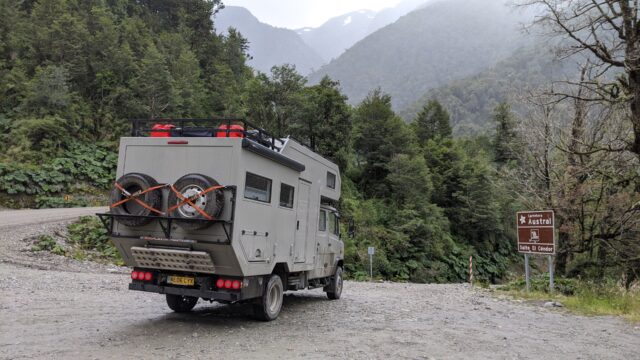
Future plans?
We’re currently heading back to the UK after our recent adventure. We were reunited with our Vario back in November 2020. We’ve been on the road since, travelling around southeast Europe, the Balkans, Albania (which was outstanding), and three months in Turkey, which is an overlanding paradise. In the UK, we’re having a pause and working on the truck whilst we plan our next big adventure.
Overlanding words of wisdom?
Keep it simple and stay flexible. Think about what could fail and how you’d fix that in a non-ideal situation. Don’t over engineer things; that’s my biggest single piece of advice.

Where can we find you?
Instagram: @le.truck.world and @famille.day
Email: nathan@day.ag
Specifications
2006 Mercedes Vario 815 DA 4×4 4259
Power
4259 OM 904 LA engine
Original power (815): 150bhp or 110kW
Uprated power (818): 181bhp or 135kW
5-speed transmission
Low-range box
Suspension and Drive
Currently, original suspension leaf springs; additional third leaf will be added to the front axle shortly
Marquart reinforced shocks/dampeners
Lockable front and centre diffs
Wheels and Tires
Super single GABO 19.5-inch steel rims all round
Pirelli TR:01 285/70R/19.5 tires
TyrePal inline TPMS
Two spare tyres; one on a rim
Recovery and Armor
4 x sandladder.net aluminium sand mats
Accessories
LazerLamps front LED spot bars
Dual (one on each side) connectors into OEM compressed air system (used for braking, diff lock, and low range gear actuation)
Victron Multiplus 3,000-watt inverter-charger
Victron 24v 400aH LiFePO4 batteries
Victron 120/230v isolation transformer
300-watt solar panels
Isotherm Cruise 200 Inox fridge/freezer
Dometic Freshwell AC
Webasto Air Top 40 high altitude diesel heater
Isotherm 600W 24-litre electric boiler
Dometic OG 3000 oven
Can 3-burner hob
Alutec roof boxes
Separett composting toilet
Fuel Capacity
70l original tank plus 80l secondary tank
Water Capacity
250-liter triple-filtered – 2 x particulate, 1 UV light
100l grey
Weight
7.5t fully travel ready; skis, SUPs and kayak included
References
Twiga Travelcars twigatravelcars.nl/en/
Marquart marquartshockabsorbers.com/
TyrePal tyrepal.co.uk/
LazerLamps lazerlamps.com/
Alutec alutec.net/en.html
Sandmats sandladder.net
El Rincon Guesthouse elrinconchile.cl/
Our No Compromise Clause: We carefully screen all contributors to make sure they are independent and impartial. We never have and never will accept advertorial, and we do not allow advertising to influence our product or destination reviews.


